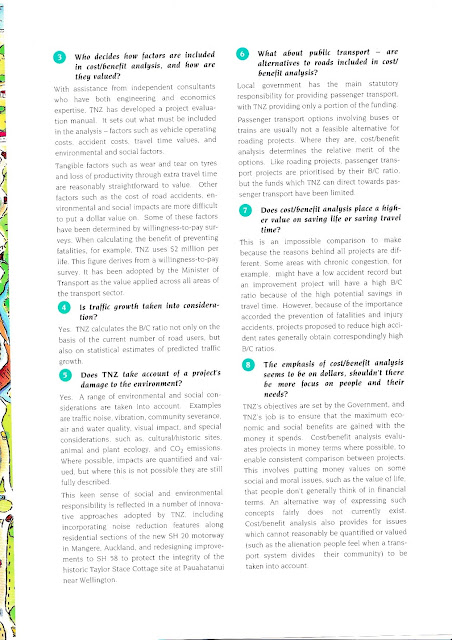 |
| Background - Project Evaluation - Stretching the budget |
 |
| How the Benefit/Cost Ratio is arrived at. Common questions about CBA |
 |
| Common questions about CBA continued |
 |
| Common questions about CBA continued |
 |
| Common questions about CBA concludes |
For the public and the media, the idea that roads and public transport would be funded based on a process of rational comparative analysis of benefits and cost was somewhat unfamiliar, compared with how most other government funding decisions were made. Transit New Zealand (still a funding agency as well as state highway manager) published this guide in July 1995 to help inform those without training in economics.
Some of the more interesting elements are:
- Why Transit NZ believes cost/benefit analysis is the right method of assessment?
- Brief history of the concept in NZ
- Factors taken into consideration
- How public transport and alternatives to roads are considered
- Allowances for natural disasters
- Specific comment on why it did not fund Auckland's light rail project (a proposal by the Auckland Regional Council to convert the rail network to light rail)
- Does most of the money go to Auckland?
Cost/benefit analysis began to be used in 1982, and became a requirement in 1988, so from 1989 Transit NZ would use cost/benefit analysis for all capital projects. At the time, Transit's view on concerns that many projects were not being funded was simply that there was insufficient funding to fund everything that had positive benefit/cost ratios (the funding threshold was 5 at the time).
Much would happen in subsequent years, within a year Transit New Zealand would no longer have a funding function (which was transferred to Transfund New Zealand), and by 2003 multi-criteria analysis was being applied until in 2008 further reforms saw the merger between Transit New Zealand and Land Transport New Zealand (returning to an integrated state highway manager and land transport funding agency, with regulatory functions) into the New Zealand Transport Agency. That legislative change under the Land Transport Management Amendment Act 2008 saw significantly greater Ministerial direction over the output classes for funding and the weighting given to objectives of land transport funding.
In 2023, Waka Kotahi uses much more complex multi-criteria analysis to assess funding proposals, with benefit/cost ratios being only part of the consideration as to the merits of projects getting funded. This leaflet harks back to an era with much more limited funds (as the amount of funding granted was determined through the standard budgetary process) and a much tighter level of scrutiny on the use of those funds.

No comments:
Post a Comment
Comments are gratefully received, but any comments including abuse or spam will be deleted